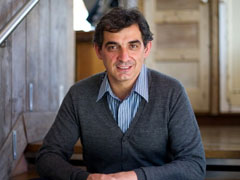


The story of King’s Cross has a familiar element: one of decline in the Victorian era due to the slum housing constructed to accommodate railway workers. But even before this, the area then known as Battle Bridge was deteriorating. In the early 1800s, the River Fleet still ran over ground, and frequently flooded the area; given that it was used as an open sewer, this was hardly ideal. A project to open a music school, art galleries and ornamental gardens failed, leaving just one public open space and nothing in terms of cultural activity. What did go ahead was a statue of King George IV (son of the “mad” King George), which would give its name to the area.
From 1850 onwards, King’s Cross and St. Pancras stations established the area as London’s main arrival point for visitors and goods from the north of England. It was hoped this would bring a breath of fresh air to King’s Cross, and while it did provide work, it also meant the destruction of many homes to make way for the new railways. This resulted in problems with overcrowding within the tiny terraces that survived to the south of Euston Road.
The post-war recession meant further decline. There was a decrease in goods traffic, leading to disused warehouses and large areas of wasteland. King’s Cross fell into disrepute, becoming well known for being London’s red light district; a rep it’s held for decades. On the other hand this also meant cheap rents, and artists like Anthony Gormley could open studios here. Opinion became sharply divided between those fearful of its seedy image and those who revelled in its bohemian character. \n\nThe government has been intent on cleaning up the area since the 90s, but it’s in the last few years that King’s Cross has seen the most change. In 2007 the Eurostar was relocated here from Waterloo, after hefty renovation of St. Pancras station. This led to new shops, restaurants, the plush St. Pancras Renaissance Hotel and most importantly, many new passengers. The expansion of the station also led to the closure of three nightclubs: The Key, The Cross and Canvas, to the chagrin of London’s clubbers. Instead it gained Kings Place, a large venue hosting classical music and jazz, art galleries and restaurants, a far more salubrious proposal.
The £800 million redevelopment of St. Pancras was just the start. The area around Goods Way, once home to little more than empty buildings and industrial wasteland is getting new streets, new homes and new fashionable places to eat. The plan is for 20 roads and 10 open spaces to be built, as well as the restoration of numerous historical buildings.
One of these is the Granary Complex, a Victorian building once used for storing and distributing grain, now housing a new Central Saint Martins campus. Two new restaurants, a second branch of Caravan and Bruno Loubet’s Granary Square Kitchen are also planned to open in the Grade II listed building.
Granary Square, one of the largest squares of its kind in Europe, is now open, however at the time of writing there is little to see here with the exception of some steps leading down to the canal; fountains are planned, as well as an ice rink. Concerns have been voiced about this “public” space being privately owned by Argent King’s Cross Limited Partnership, a growing trend in the UK. Private ownership of squares, thoroughfares and streets could mean refusing entry at will, and being faced with a barrage of advertising rather than an expanse of green grass and pretty flower gardens.
The fancily named Kings Boulevard isn’t on Google Maps yet, but it’s open, leading from Granary Square to the station. From Monday to Friday there’s a street food market on between 11 am and 2.30 pm. The rest of the time it’s a gravelled walkway with boards displaying pictures of green leaves on either side, tables and chairs, and signs with the names of the surrounding streets, marking out King’s Cross as an attraction, like Covent Garden. \n\nThere’s another large square opposite the entrance to King’s Cross station with ping pong tables that have been installed for the summer of 2012, in honour of the Olympics. The skyline is dominated by cranes, as there is still much work to go, with the St. Pancras clock tower peering through them.
Google UK, Argents, engineers Hoare Lea and BNP Paribas are to move into new offices here over the next four years. Undoubtedly this regeneration project is providing employment to many; Argent’s chief executive has stated that 8,000 jobs would be created, “enough for every school leaver in the borough”. In terms of housing, a total of 1,900 new homes are in the pipeline, 44% of which will be classified as affordable housing, such as part rent part buy schemes. The homes will be aimed at locals, and some will be care homes for elderly.
The area’s redevelopment represents big money for the developers and the retail units that will be moving in. N1C, London’s newest postcode, is set to be a success. But will the residents of neighbouring Somers Town reap any of the benefits? Hopefully, as £1.4million has been earmarked for the Decent Homes programme in the area.
As with much of London, King’s Cross has metamorphosed several times. What will be dreamt up next? A high speed train to Beijing? Maybe, as Chinese developers are in negotiations to build a railway that will transport passengers to China’s capital city in two days. After that who knows, perhaps St. Pancras International will expand yet again to house a launch pad into space.


